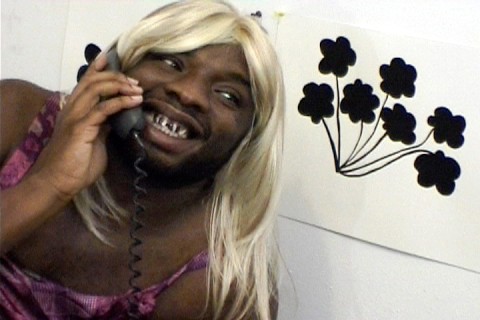American painter, writer, director, actor, editor, singer-songwriter, and performance artist, Kalup Linzy is best known for his video series that deal with race, class, sexuality, and family dynamics within the formal system of daytime soap operas. Linzy supplants the predominantly white, middle-class, heterosexual characters of daytime dramas with figures who represent his own background as a gay, black male artist who was raised in the rural South. The low-tech, do-it-yourself aesthetic of his videos—spare production, campy performances, and rudimentary direction—gives them a gritty realism and conveys the personal nature of Linzy’s artistic practice. Indeed, his earnest expressions of loss and longing, aspiration and disappointment allow his art to maintain its sincerity while it emulates and satirizes popular cultural forms and the social politics of the art world.
Born in 1977 in Clermont, Fla., and raised in the nearby, rural town of Stuckey, Linzy received his B.F.A. and M.F.A. from the University of South Florida in 2000 and 2003, respectively. He later attended the Skowhegan School of Painting and Sculpture, and had solo exhibitions at the Berkeley Art Museum; the Studio Museum in Harlem, P.S. 1 Contemporary Art Center in Long Island City, NY; and LAXART in Los Angeles. He has also received grants from the Harpo, Jerome, Creative Capital, Louis Comfort Tiffany, and Guggenheim Memorial Foundations. Furthermore, in July 2010, he made his debut appearance on ABC’s daytime drama _General Hospital_.
As a youth, Linzy lived with his grandmother, an avid watcher of soap operas, and he performed musical numbers for his church congregation and family members. These experiences influenced his early work in art school, where he produced vignettes that developed into his acclaimed _Conversations wit de Churen_ series. Also inspired by the early films of John Waters and Andy Warhol, as well as performances by RuPaul, Lily Tomlin, Flip Wilson, and those on the 1990s sketch-comedy show _In Living Color_, Linzy’s videos features a remarkable cast of characters. Taiwan, Katonya, Labisha, and Nicuazia, among others, are mostly performed by Linzy in drag. Used as a liberating technique, drag allows Linzy to approximate emotional truth rather than femininity, as he plays his many female characters with obvious facial and body hair, and often sans make-up. Linzy also digitally voices and overdubs all of his characters’ dialogue in a black southern dialect. The dislocation of image and sound creates an uncanny ventriloquistic effect. Nonetheless, his videos require the viewer to look beyond the surface as the narratives dissect a variety of societal and personal relations, making the works universal and engaging the audience in the characters’ plights.
In _Conversations wit de Churen III: Da Young and Da Mess_ (2005), for instance, Linzy plays Taiwan, a drag queen and aspiring singer who receives a marriage proposal from his boyfriend Harry. Taiwan plunges into an emotional crisis furthered by incessant phone conversations with his mother, grandmother, and psychic (all played by Linzy). They live in a small town, and while Taiwan loves Harry, he does not want to marry him without the support of his church, family, and community. Despite the on-screen stereotypes and histrionics, _Da Young_ deals with a poignant real-world dilemma.
Likewise, _Melody Set Me Free_ (2007) hilariously and heartbreakingly depicts young singer Patience O’Brien’s quest for stardom. She goes against her mother’s wishes and journeys to New York City to compete in a talent show competition. Despite the fact that her backstabbing opponent, Grace Jackson, sabotages Patience's performance, Patience receives a record deal and a boyfriend in the end. In _KK Queens Survey_ (2005), Linzy also plays an artist who participates in a revealing phone survey regarding art world affairs. Questions include, “Metaphorically speaking, how many asses do you kiss a week?” and “How many movers and shakers in your art community do you sleep with a month?” These works, as in many others by Linzy, speak to the hope of acceptance and the disappointment of rejection in various cultural contexts.
_Conversations wit de Churen V: As da Art World Might Turn_ (2006) also skewers art world politics in the saga of Katonya, an aspiring painter. As she has melancholic dialogues with God, Katonya struggles with the uncertainty of her relationship with Big Feet Freddy, and the demands of her upcoming gallery show, both of which she eventually triumphs. Despite the appearance of Linzy in a blonde wig and bustier for most of the video, his character Katonya functions as a surrogate for not only himself, but also many young emerging artists who must deal with emotional and financial instability. Conveying his identification with the characters and subject matter, Linzy’s performances are not merely ironic, they effectively blur distinctions between high and low and art and life. _—Kanitra Fletcher_

